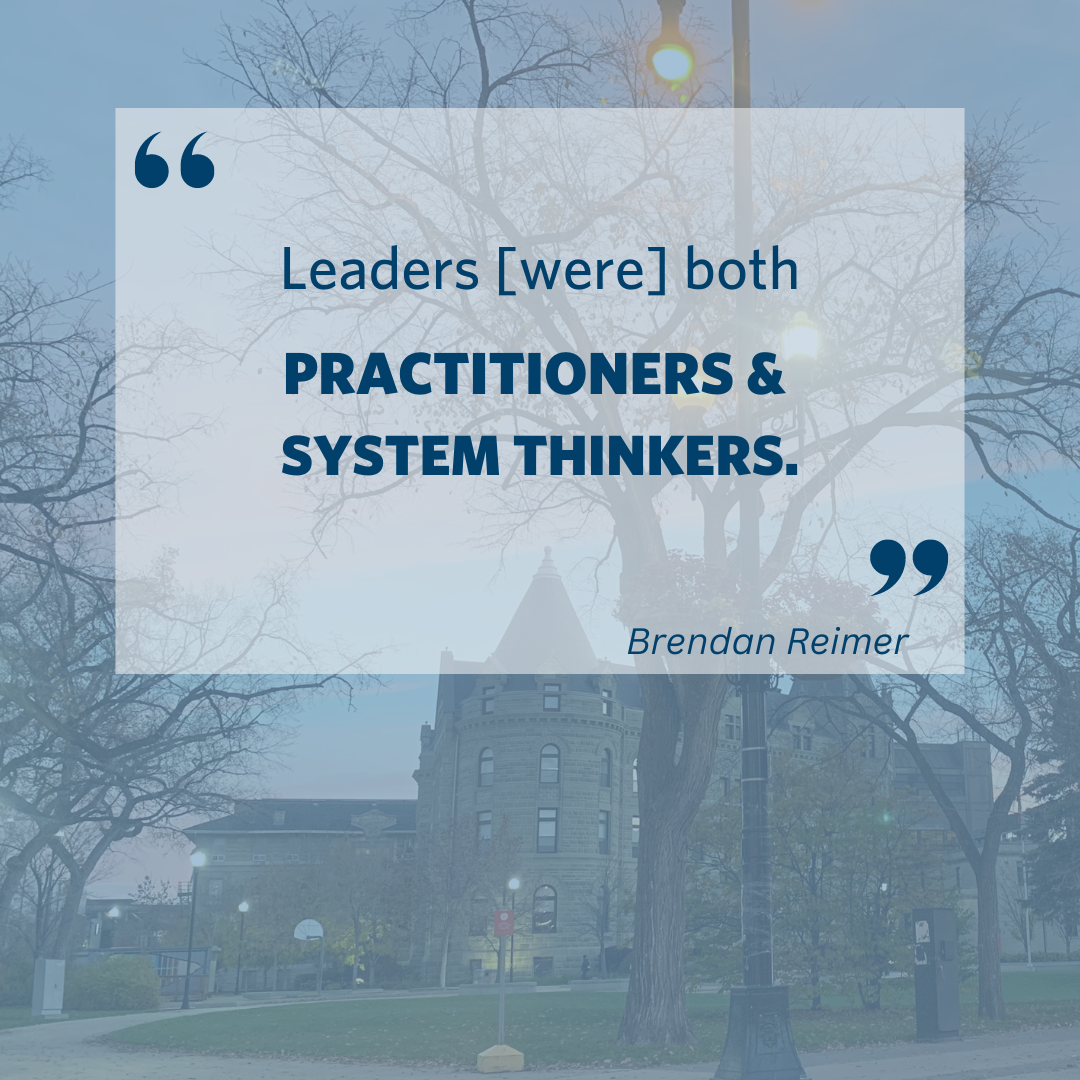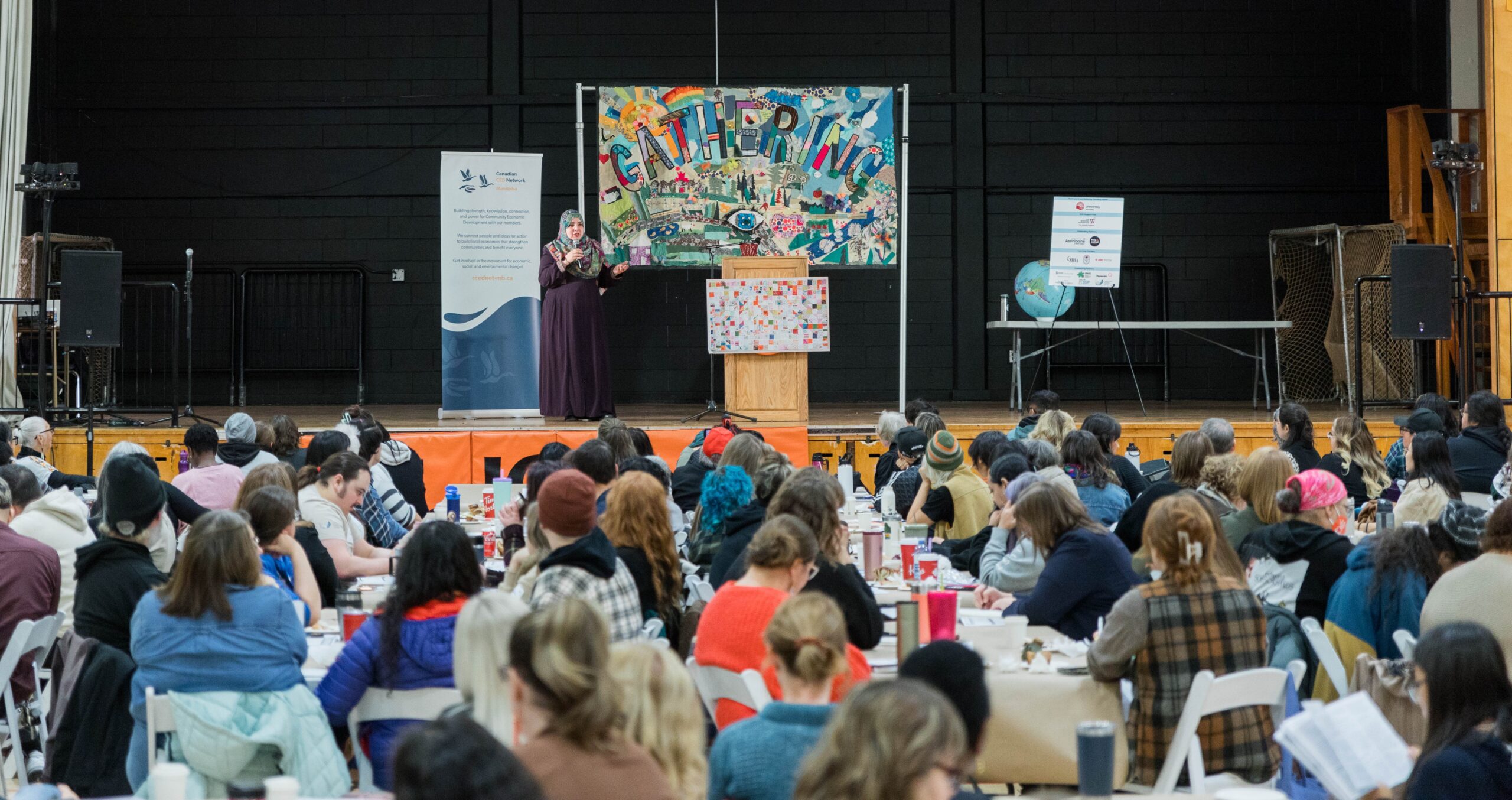This is Part 6 of our Ecosystem Building Blog Series.
part 1) Pan Atlantic,
part 2) Saskatchewan,
part 3) Ontario,
part 4) Newfoundland and Labrador – 1,
part 5) Newfoundland and Labrador – 2
Ecosystem building is a core focus of CCEDNet’s Regional Initiatives Program.
Stronger [balanced] together:
How pragmatics, changers, philosophers and visionaries built Manitoba’s ecosystem
A coffee chat with Brendan Reimer.
Interview With
Brendan
Reimer
Sarah
Leeson-Klym
CCEDNet
Mike
Toye
CCEDNet
Melissa Sinfield
CCEDNet
Editor:
Melissa Sinfield, Regional Initiatives Manager
Blog Summary
Read this if you are:
- Wondering what factors might support establishing a lasting community economy ecosystem?
- Curious how balance may be the key to lasting relations and sustainability for regional ecosystems?
- Questioning whether to start building your ecosystem with a focus on structure or action?
- Wanting to learn how CCEDNet Manitoba’s ecosystem came into being?
Blog Notes:
Region: Manitoba
We spoke with Brendan, who served as Director of CCEDNet Manitoba for the first 11 years, building many of the network functions still being practiced today.
To learn more about other ecosystem building projects and approaches that have been supported by CCEDNet check out our Regional Initiatives Program.
Note: interview has been edited for length and clarity.
How did CCEDNet Manitoba come to be?
THE OPPORTUNITY:
1) A groundswell of collaborative energy wanting systems change
Brendan: At the time there weren’t as many collaborative groups and there was a sense that something different or new was needed given the needs we faced as a community: housing, food security, poverty.
There was a group of young organizers, some students, who were all keen to work together and saw the value of creating associations. CCEDNet also already had a local presence since one of the founders and first Executive Director, Garry Loewen, was based here. So, the network came together. Around this time other collaborations (such as Manitoba Co-op Association) were also growing or being created including Food Matters Manitoba, Right to Housing Coalition, the CCPA-hosted Manitoba Research Alliance on CED and the New Economy, and Make Poverty History Manitoba to name a few.
The collaborative groups were also specific communities of practice. There weren’t as many at the time, but there were great collaborative groups emerging with place-based work (example: Neighbourhood Renewal Corporations) and within Indigenous communities.
LOCAL & INTERCONNECTED
2) Grounding systems change ecosystems in local realities
Sarah: Location matters. Given the reality of innercity poverty here, it’s so obvious that there is a systems problem in Winnipeg. Do you think that is part of why CCEDNet [a systems-change focused network] has sustained here?
Brendan: Yes. The Winnipeg reality matters. Everyone knew each other: the leaders and mentors knew each other, the student researchers and young leaders all got to know each other as well as getting to know the leaders and mentors.
We all had our offices here, as most provincial associations and collaborative initiatives have their head office or base here in Winnipeg. These experienced and emerging leaders had a simple mentality–or perhaps actually more complex– they shared a common understanding of how we were all in it together and how everything was interconnected: housing, food, co-op development, public policy, funding and finance, environmental sustainability, and what we now refer to as reconciliation. Also having a network employee connecting people, and so many of us having schooling on CED or related topics, it all cemented everything. Also, it helped to have politicians growing up working in these communities before they entered politics. Over time, we start having deep, meaningful ties. That’s true of academics here too.
“
These experienced and emerging leaders… shared a common understanding of how we were all in it together and how everything was interconnected
“
With experienced and emerging leaders being grounded in a theory of change that was community-led and holistic, and with so many participating in the Manitoba Research Alliance projects where we needed to explain our concept and theories as part of writing the reports, we came to understand our common language and our common approach and our interconnectedness to each other.
3) Shared vision and an intersectional systems change mindset
Brendan: I think one key reason why CCEDNet emerged in this context is that the leaders (and the younger folks they hired and mentored) understood CED to be broader system change work that consisted of all those various initiatives and sectors working together in a common philosophy of engaging communities and building sustainable, fair, inclusive local communities and economies.
I think some regions might have defined CED more narrowly, which is why some of those broader networks didn’t understand how they connected and related to CCEDNet, but in Manitoba the ethos and philosophy positioned CCEDNet as the hub of the wheel connecting the groups together, or the umbrella as an overarching development paradigm they shared.
One aspect that built this common understanding and culture is the Manitoba Research Alliance on CED in the New Economy and the subsequent SSHRC projects after it. The CED leaders were part of the leadership of this research, and many of the “younger leaders” were student researchers mentored and funded through that program that turned into jobs.
“
[T]he leaders… experienced and emerging leaders… understood CED to be broader system change work that consisted of all those various initiatives and sectors working together.
“
As I think about this more, each research project would have had literature reviews and a section defining terminology and theory of practice or concept, and so every student researcher (and academic partner) along with the community partners would have been researching, writing, learning, developing, and articulating these aspects of a research paper and that process would have grounded us all in a theoretical framework of CED philosophy (as that was the focus of all the research). This would have had quite an impact on our collective mindset and approach to our work and each other.
4) Intergenerational sharing and setting aside ego
Brendan: I would add that the younger leaders who emerged in this space had a good way of working together, it wasn’t about the egos, it was about having a common and broader vision for our work and how it was all interconnected with each other. But I’d also say that we all had more experienced mentors as well who taught us about the interconnections – CED, social enterprise, co-ops, poverty, housing, Indigenous organizations, etc all had very experienced people leading the way and mentoring the younger staffers brought in to lead the networks. I am extremely grateful for the time they invested in me and the other emerging leaders, and I think the legacy of their efforts lives on today.
“
[It] wasn’t about the egos.
“
ALIGNMENT
5) Building fertile ground for a CED ecosystem through aligned approaches and language
Brendan: CED was also common language in Manitoba, where organizations like Neechi Foods, LITE Winnipeg, SEED Winnipeg, Jubilee Fund, Community Futures, Neighbourhood Renewal Corps, and by then even the Province of Manitoba used the language of Community Economic Development. So many leaders in so many different organizations and institutions were very familiar with the terminology, principles, and philosophy of CED.
“
CED was also common language in Manitoba.
“
By 2003, about when I started, there was a CED Policy Framework and Lens at the Province of Manitoba. About that time United Way Winnipeg hired one of the top CED leaders to develop a strategy around CED, and shortly after the Winnipeg Foundation did the same thing. Assiniboine Credit Union launched a CED Strategy, University of Manitoba and University of Winnipeg had authors publishing and teaching about CED (John Loxley, Jim Silver, etc.), and the Manitoba Research Alliance had millions of dollars to lead dozens of CED research projects engaging dozens of community organizations, academics, and students.
There is so much more that was in place and emerging, but this was the context of Manitoba and why CCEDNet Manitoba grew the way it did as well, it was extremely fertile ground for something to grow – and CCEDNet Manitoba did.
LEADERSHIP & TRUST
6) Finding a leader who the network trusts to centre multiple approaches and perspectives
Sarah: What made it okay to trust CCEDNet?
Brendan: As in, why were local practitioners willing to trust this unknown upstart new national network?
The answer to that in part is that Garry was a founding member of CCEDNet and then the first Executive Director of CCEDNet. He had experience, and a nuanced understanding of the need for balance between practitioners and visionaries.
The local leaders trusted Garry, and if Garry was a leader in CCEDNet, they would trust CCEDNet because they trusted Garry. There were many others who played important roles in that part of building trust in CCEDNet, but I want to highlight that aspect of how he brought a nuanced understanding of blending vision and practice which was really key to the culture.
Mike: So it was a mix of collaborative energy and culture?
Brendan: And trust.
“
[Leadership with] a nuanced understanding of blending vision and practice which was really key to the culture.
“
Editors note: We also have heard that when the national network was emerging, local practitioners were connecting with and inspired by people working in other provinces. However, in a place like Manitoba where many feel that other regions don’t understand the context, having a local leader made a difference.
SUSTAINING
7) Formalizing structures of accountability
Sarah: The organizational structures were collaborative. How did you sustain that moving forward?
Brendan: Through some humbling moments where we were challenged to do better. CCEDNet was called out for presenting ourselves as representing other communities while lacking a formal democratic process that would give us the legitimacy as representatives of the sector. And they were right. We thought we were being representative but we weren’t doing enough. The network wanted it with more formality and accountability. They wanted a clearly outlined structure and decision making process, especially when it came to public policy advocacy.
Editor’s note: CCEDNet Manitoba now uses a member voting structure and resolution framework, particularly with the Manitoba public policy advocacy work. The models are closely reminiscent of co-op and union models likely reflecting the strong co-op and union networks that span much of Winnipeg, and Manitoba more broadly. Brendan’s note: In fact, the people who helped CCEDNet form our current process all (from what we recall) came from student union backgrounds including one long-time policy forum facilitator.
8) The importance of resourcing paid positions
Sarah: We definitely had alignment with the government for a long time which made a difference, but the work of CCEDNet Manitoba kept going even when the alignment wasn’t there. How come we were able to sustain?
Brendan: There are other factors. As mentioned, there were resources from other sources as well, along with a well-established network of leaders who were committed to the common vision. But one key was that we had paid staff in Manitoba, whereas when we looked into other regions we saw how volunteer-based networks struggled to sustain their work and impact.
Sarah: So how important is it to have paid positions?
“
It’s about building resilience and sustainability over time, and this is more possible with a dedicated staff person who is able to build a network over time. .
“
Brendan: It is very important, as you need dedicated time for building a strong and effective network and that is very difficult to do without having a person who is able to fully focus on doing that. It’s about building resilience and sustainability over time, and this is more possible with a dedicated staff person who is able to build a network over time.
Mike: When provincial support ended, the Manitoba network could survive because they’d built ongoing support with other local funders like United Way Winnipeg and Winnipeg Foundation.
9) Strategic positioning of leadership
Brendan: I’ll add one more key to the evolution in Manitoba, that the ecosystem being built created a very fertile and nurturing environment for CCEDNet Manitoba. Over time, community leaders who aligned with CCEDNet’s emerging vision were strategic about positioning themselves and advocating for change in key institutions like governments, funders, and financial institutions. I think that the fact that my original Prairies Coordinator role was in Winnipeg was likely, in part, because of the existing organizing work of local leaders in these institutions.
BALANCE AS THE KEY
10) Balancing Action and Structure
Brendan: We had a mentality of needing to figure out what needs to be done and then doing it. Manitoba leaders were very focused on action and outcomes that mattered most to communities. It was the belief that we needed real change in communities.
Mike: Interesting contrast between outcomes versus structure. In Quebec they say it isn’t worth trying to predetermine and focus on set outcomes — those will change as situations evolve, but if you have good, community-rooted structure, positive outcomes (often previously unpredictable ones) will happen.
Sarah: Structure is sustainability.
“
We had a mentality of needing to figure out what needs to be done and then doing it.
“
Brendan: It has to be both, but you can’t have just structure at the beginning or people will be tired of investing their time in building structure without seeing outcomes that matter to their mission and vision of community.
Editor’s note: Beatrice, from Chantier, QC, has mentioned before the importance of having short term wins that can bolster motivation and resolve of the network so momentum is not lost. This may be part of the nuance behind why the formally structured Quebec model was so successful. Similarly, the action heavy Manitoba model was likely sustained through implementing the formal structures shortly thereafter, which were noted above. The trick is likely understanding which approach would be better received in a region during the initial years, and finding ways to lean into that approach while counterbalancing it with the other. They may not need to be treated or understood as opposites, but complementary approaches.
11) Balancing the thinking and action for systems change
Melissa: What about the different roles that practitioners and systems thinkers played as this ecosystem emerged?
Sarah: Community development practitioners care about the change, and what change looks like.
Brendan: Which came first?
The practical practitioners or the system change thinkers?
I think an interesting thing in Manitoba is the number of leaders who are both practitioner and system thinkers: we had top-level academics who were actively involved in co-op development, network leaders who were system-thinkers and practitioners leading music festivals and on boards of neighbourhood renewal corporations, we had practitioners of community organizations who completed PhD while they were at it, and so forth.
“
[A]n interesting thing in Manitoba is the number of leaders who are both practitioner and system thinkers.
“
It’s about understanding you’re part of a broader system and having a vision for a whole community.
Sarah: There was some intentionality behind it.
12) Balancing pragmatics, changers, philosophers, and visionaries
Brendan: Part of building this network was regular meetings over coffee and chats: talking, disagreeing, addressing issues and opportunities.
Sarah: The network we have here is full of community organizations, the front line folks. In other regions, there is more emphasis on networks-of-networks, which probably makes sense in larger provinces. In Manitoba though, there is less separation between the networks and the front-lines, and lots of connections between research and everyone else. An example of this is the Urban and Inner City Studies program with professors who are involved, experiencing the reality of work in communities.
Brendan: What’s clear is you need a balance:
- You need pragmatic people, but not just pragmatic practitioners
- You need architects of systems change, but not just systems changers
- You need philosophers and visionaries, but not just philosophic academics and visionaries
It’s all of them together.
Mike: Also a Theory of Change.
THE IMAGINARY
13). Collectively imagining a shared, better future as a powerful tool for sustaining the movement
Sarah: What I am hearing is networks have to bring these different types of people together because they balance each other – practitioners might struggle to continue believing in the possibility of change or feel they have the time to connect across sectors as they navigate heavy day-to-day challenges while academics or collaborative leaders might lose sight of the day-to-day realities in community without being grounded in it.
Brendan: Perhaps that’s the role of CCEDNet to teach the network? The collective imaginary. Intellectual and creative. Bring together the practitioners, the visionaries, the intellectuals and the creative solution builders, and all others involved to build the common imagination and vision of the world we want to build.
Sarah: With the Manitoba Gathering, we started to think differently in how we designed it. We created a day where the community comes together each year imagining that the whole economy could be this. ‘Oh, there’s hundreds of us, maybe we can make change!’ It’s not marginal anymore. It is when they click into that imaginary, that solidarity. It’s so powerful. It is what sets the Gathering apart. But it’s hard to write that into a funding report!
“
[When people]
click into that imaginary,
that solidarity.
It’s so powerful.
“
Brendan: Probably one of the hardest things to do, to explain in a funding application. Has CCEDNet done that successfully in other places?
Sarah: I’m not sure we’ve achieved it completely, but this is what we are trying to work towards doing here with the Regional Initiatives program!
CONSISTENT CONNECTION
14) Hosting frequent get-togethers and predictable annual gatherings
Melissa: Two recurring and interconnected threads I am hearing are balancing voices and approaches and doing this by keeping everyone connected, including:
- Frequent informal small get-togethers: such as the small weekly coffee chats of “talking, disagreeing, addressing issues and opportunities” that Brendan mentioned earlier.
- Formal structured gatherings: including reliable and predictable events for collaborative action and accountability such as the annual formal policy convenings.
- Morale boosting visioning gatherings: such as the larger annual events for building and feeding the imaginary to maintain long term momentum like the Manitoba Gathering.
- Ongoing meetings and convenings: such as all the frequent meetings and partner convenings that go on behind the scenes that sustain those connections throughout the year.
All this ties back to the earlier point made on the importance of having a paid staff for sustaining ecosystems in the long term, because the amount of energy needed for building and maintaining these types of connections and systems is quite significant.
Thank you Brendan, this conversation has been so insightful!
_________
Thank you Brendan!
We would like to extend a warm thank you to Brendan Reimer for taking the time to chat with us on the history of CCEDNet Manitoba and for all the thoughtful revisions that added deeper nuance to the conversation.












